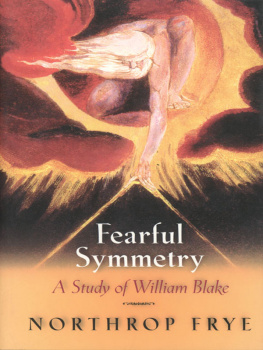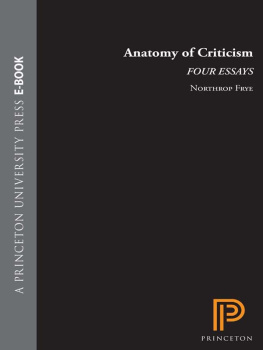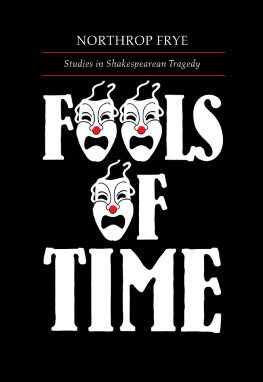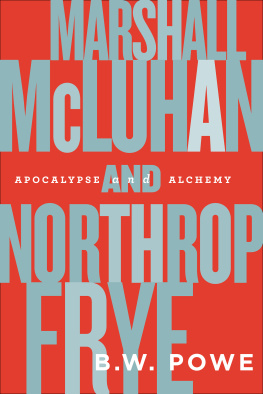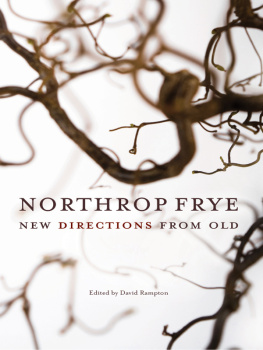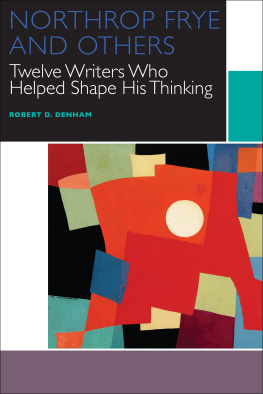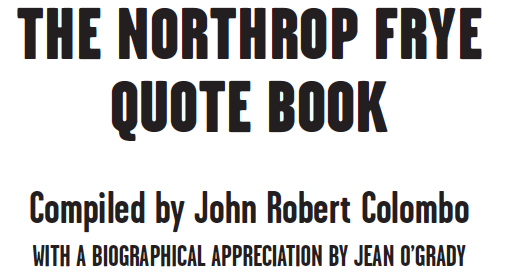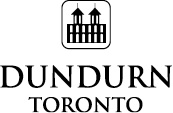Cover
Copyright John Robert Colombo, 2014
Northrop Frye quotations copyright Victoria University (in the University of Toronto), 2014
Introduction and Selection copyright John Robert Colombo, 2014
Biographical appreciation copyright Jean OGrady, 2014
All rights reserved. No part of this publication may be reproduced, stored in a retrieval system, or transmitted in any form or by any means, electronic, mechanical, photocopying, recording, or otherwise (except for brief passages for purposes of review) without the prior permission of Dundurn Press. Permission to photocopy should be requested from Access Copyright.
Editor: Dominic Farrell
Design: Jesse Hooper
Epub Design: Carmen Giraudy
Library and Archives Canada Cataloguing in Publication
Frye, Northrop, 1912-1991, author
The Northrop Frye quote book / edited by John Robert Colombo ; foreword by Jean OGrady.
Includes bibliographical references.
Issued in print and electronic formats.
ISBN 978-1-4597-1958-3 (pbk.) ISBN 978-1-4597-1947-7 (pdf).-
ISBN 978-1-4597-1948-4 (epub)
1. Frye, Northrop, 1912-1991--Quotations. 2. Criticism--Quotations. I. Colombo, John Robert, 1936-, editor of compilation II. Title. III. Title: Quote book.
PN75.F7A25 2014 801.95092 C2013-907425-2
C2013-907426-0
We acknowledge the support of the Canada Council for the Arts and the Ontario Arts Council for our publishing program. We also acknowledge the financial support of the Government of Canada through the Canada Book Fund and Livres Canada Books, and the Government of Ontario through the Ontario Book Publishing Tax Credit and the Ontario Media Development Corporation.
Care has been taken to trace the ownership of copyright material used in this book. The author and the publisher welcome any information enabling them to rectify any references or credits in subsequent editions.
J. Kirk Howard, President
The publisher is not responsible for websites or their content unless they are owned by the publisher.
Visit us at: Dundurn.com
@dundurnpress
Pinterest.com/dundurnpress
Facebook.com/dundurnpress
Contents
Introduction
There is no Canadian writer of whom we can say what we can say of the worlds major writers, that their readers can grow up inside their work without ever being aware of a circumference.
Northrop Frye came to that conclusion after a detailed study of the imaginative achievements of Canadas writers from the earliest period to 1965 when that sentence from his study first appeared in print. Over the decades since then, the statement has come to be regarded as a benchmark of individual and national literary achievement. It might or might not have been true at the time; it may or may not be true today. Its singular deficiency is that it fails to take into account the phenomenal cultural achievement of Northrop Frye himself.
When we think of the worlds major writers, we tend to think of creative writers of poetry and fiction, and only then of the writers of dramas, essays, biographies, and memoirs. Only as an afterthought does it occur to us to include writers of criticism literary, philosophical, social, cultural. Even with the admission of theoreticians and critics to the ranks of creative writers, they are seen to be there on sufferance, as lurkers rather than as full participants. Yet our understanding of the world and our appreciation of its literary heritage would be greatly diminished if we relegated theory and criticism to also-ran status. Robertson Davies, himself a novelist, essayist, and dramatist, was also a trenchant critic; he once observed that no one had ever erected a statue to a critic. For reasons of sentiment and patriotism, statues are regularly raised to honour popular (or once-popular) artists. Indeed, it has been claimed that there are more memorials to the immortal memory of Robert Burns in Canadian cities than there are in his native Scotland. But has any author of criticism ever been honoured with a single statue or public memorial in Scotland or Canada?
There is, however, no need to raise another monument to recall the achievement of Northrop Frye. His thirty-volume Collected Works , the effort of a lifetime and the twenty-year labour of dozens of scholars, is itself a considerable achievement, and a suitable memorial in keeping with the seriousness of a man of exceptional modesty (though there was nothing modest at all about his aims and objectives as a critic!). His presence is recalled in the naming of Northrop Frye Hall, which rises close by the E.J. Pratt Library on the campus of Victoria College, University of Toronto. Well it marks his association with that venerable educational institution from the year 1929, when at the age of seventeen he enrolled as an undergraduate, to the year of his death at the age of seventy-nine in 1991, when he served still as chancellor emeritus and university professor.
His courses on the symbolism of the Bible and on modern poetry, as well as those on Milton, Spenser, and the Renaissance, not to mention Blake, were hugely popular. It used to be said that students entered first year at Vic as believers in the existence of God; they lost their religious faith in second year; but they regained their faith in third year, when they realized that Northrop Frye was God! As well, for a heady period in the 1970s, Frye achieved renown as the worlds most widely quoted contemporary scholar in the field of the humanities. In sum, he may well be the single Canadian author who offers his readers the opportunity to grow up inside their work without being aware of a circumference.
The present book is a compilation of more than 3,600 quotations taken from the writings of Northrop Frye, writings both published and unpublished during his lifetime, selected to illuminate topics that were of special concern to him and are subjects of general interest to the reader today, whether scholar, student, or browser. The quotations appear under alphabetically arranged headings approximately1,140 of them, from A to Z so that the reader may easily have at his or her fingertips the insights of one of the worlds leading literary critics. The present work might be described as both encyclopaedic and episodic; Frye, in his own terms, would characterize it as both diachronic and synchronic.
To give some instances, included are entries on specific subjects Accountants, Advertising, Atlantic Seaboard, Americanization as well as on general subjects Abstract Expressionism, Absurdity, Allegory, Art to limit the inquiry to the first letter of the alphabet. Attempts have been made to select passages for inclusion that are short, self-contained, and significant. In describing a passage as significant, what is meant is that the quoted matter is interesting in its own right or important in the eyes of the world.
The purpose of this dictionary of quotations is to delight and instruct, to recall a touchstone remark: delight the specialist user with unexpected insights and instruct the novice reader with variations on received opinions. Both the specialist and the browser alike might express surprise at the authors erudition particularly the immense range of works that Frye makes reference to in his studies, a range that displays his familiarity with both the serious literature of the past and the popular writing of the day (not that he would endorse those terms). In compiling these passages, I was always surprised at how much he had read and had noted. I was struck by the truth of David Stainess observation: In whatever direction you happen to be going, you always meet Frye on his way back.


